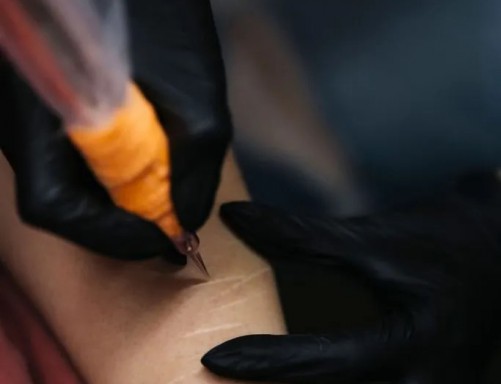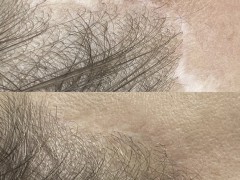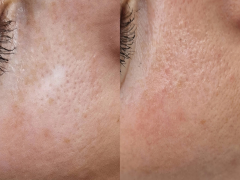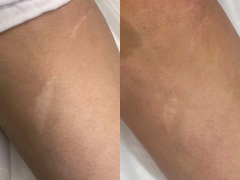Scar camouflage tattooing is a specialized technique designed to blend scars with the surrounding skin, creating a smoother, more even texture and disguising imperfections. Using skin-toned pigments, this treatment effectively reduces the visibility of scars, restoring your skin’s natural appearance and enhancing your confidence.
As a certified artist trained in NUE Conceal, I specialize in advanced scar camouflage techniques, customizing each treatment to match your unique skin tone and needs. To ensure the perfect pigment match, I use a state-of-the-art skin tone reader, a unique tool that helps me blend pigments precisely to your skin tone for the most natural and seamless results.
Think of it as a semi-permanent solution to scars, providing you with a flawless finish that lasts. After the healing process, scars are significantly less noticeable, giving you the confidence to wear whatever you love—whether it’s exposed skin or your favorite outfits.
Duration: 2-3 hours (depending on the treatment area)
Pricing: Varies depending on the size and complexity of the scar

- Reduces the Appearance of Scars – Helps scars blend in with the surrounding skin, making them less visible.
- Boosts Confidence – Many clients feel more comfortable in their skin after treatment.
- Long-Lasting Results – Unlike makeup, which washes off, scar camouflage can last for years.
- Safe & Non-Invasive – A great alternative to laser treatments or surgical scar revision.
- Custom Color Matching – Pigments are tailored to each client’s skin tone for a seamless blend.
- Improves Skin Texture – Some techniques stimulate collagen production, which can enhance skin smoothness.
What Scars Does Scar Camouflage Work Best On?
- Fully Healed Scars – Must be at least 12–18 months old and fully healed.
- Lighter Than Surrounding Skin – Works best on hypopigmented (white or lighter) scars.
- Flat or Slightly Raised Scars – Ideal for flat, smooth scars or slightly raised ones.
- Surgical Scars – Effective on C-section, tummy tuck, facelift, mastectomy, and other surgical scars.
- Burn Scars – Can be camouflaged if they are smooth and fully healed.
- Injury Scars – Including scars from accidents, cuts, or lacerations.
- Breast implant (liposuction), self inflicted or accidental.
By following these pre-care steps, you ensure that your skin is in optimal condition for the procedure, allowing for better pigment retention, faster healing, and the best possible results.
1 Week Before Your Appointment
• Avoid sun exposure and tanning (including tanning beds) on the area to be treated. Sunburned or tanned skin cannot be treated.
• Discontinue use of Retinols, AHAs, BHAs, or exfoliating products on the area.
• Do not schedule any laser treatments, chemical peels, or waxing on the area within 7 days of your appointment.
24-48 Hours Before
• Stay well hydrated. Drink plenty of water to help your skin stay supple and support the healing process.
• Avoid alcohol and caffeine (coffee, energy drinks, etc.) 24 hours prior to your session to minimize sensitivity and bruising.
• Do not take blood-thinning medications such as Aspirin, Ibuprofen, or fish oil (unless prescribed by a doctor), as these may increase the risk of bruising or bleeding.
Day of the Procedure
• Shower before your appointment, as you’ll need to avoid getting the treated area wet for 24 hours afterward.
• Do not apply lotions, oils, or perfumes on the treatment area.
• Eat a light meal before arriving to avoid feeling lightheaded during the procedure.
• Arrive with clean skin—no makeup, deodorant, or products on the area being treated.
• Wear loose, comfortable clothing that allows easy access to the treatment area and won’t rub against your skin post-procedure.
1.Consultation & Patch Test: The process begins with a consultation to assess the scar type, age, and color. A patch test may be done to ensure proper pigment selection and healing.
2. Color Matching: We have revolutionary skin tone device that reads a person’s skin tone.
3. Scar Preparation: If necessary, skin treatments (such as microneedling) may be recommended beforehand to smooth and prep the area.
4. Pigment Application: A tattooing machine with a fine needle deposits pigments into the scar. Layering techniques are used to mimic the skin’s natural color variations.
5. Healing Process: Initial healing takes about 7–14 days, but full results develop over 4–6 weeks. Some clients may need multiple sessions for the best outcome.
6. Touch-Ups & Maintenance: A follow-up appointment ensures the pigment has healed properly and allows for adjustments if needed. Results can last several years but may fade over time, requiring occasional touch-ups






THE PIGMENTATION WILL GRADUALLY FADE OVER TIME, BUT HEALING PERIOD MAY VARY BETWEEN INDIVIDUALS. WHILE SOME MAY HEAL COMPLETELY WITHIN A WEEK, OTHERS MAY TAKE LONGER. IF THE TREATED AREA REMAINS BROWN, IT INDICATES INCOMPLETE HEALING, SO PATIENCE IS ADVISED AS EVERYONE'S HEALING PROCESS IS UNIQUE.
To prevent any infection, please take your time to read and follow this aftercare.
Dry the area with toilet paper or a fresh, clean towel.
Apply ointment Aquaphor 2x per day for 8 weeks (or until your next treatment).
Protect the treated area by always wearing clean, loose shirt/jogging pants.
Removing scabs
Taking immersion baths (swimming pool, beach, bathtub)
Going to saunas
Allowing excessive sweating (workout)
Exposing the area to excessive heat and suffocation (tight clothes)
- THINGS TO AVOID:
- No saltwater, no exfoliation, no laser hair removal or waxing on areas for 14 days
- 1st 30 days, do not use sunscreen, sunblock, self-tanning or any substance that contains vitamin D
- Do not shower with hot water as it may cause irritation for the first few days.
- Do not take vitamin D pills
- If there is any allergic reaction, please call your physician
- Sunbathing is strictly forbidden for the next 30 days.
The treated area may appear red and swollen immediately after the treatment.
After 24 hours, the swelling will subside, but the redness may persist for up to 72 hours.
Following 72 hours, the redness will gradually transition to a brownish tone (hyperpigmentation).
Hyperpigmentation might persist for a period ranging from one to three months.
If the treatment was performed on the legs, the healing process may extend up to six months, especially for individuals with darker complexions.
Please refrain from being alarmed if the hyperpigmentation takes some time to fade; this is a normal part of the skin's healing process. To expedite healing, it's advisable to avoid foods and beverages high in sugar, as elevated sugar levels can prolong the healing process. Instead, focus on consuming vegetables, as many of them possess healing properties (consult your doctor if you have any underlying medical conditions).
Smoking can also impede the healing process.








